Since 2020 and the lockdown for Covid I have had a passing interest in operating through satellites on the VHF/UHF bands, each year meaning to get the necessary antennas and radios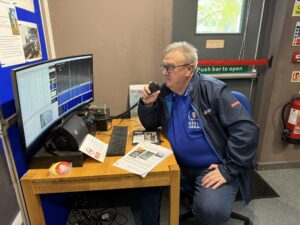 together to set up from home. This still hasn’t happened, but maybe it will in the next year. Then following a trip to Bletchley Park with my radio club (Hinckley ARES) and operating the QO-100 station the RSGB have in the National Radio Centre I decided I was going to get on the air and set up my own station.
together to set up from home. This still hasn’t happened, but maybe it will in the next year. Then following a trip to Bletchley Park with my radio club (Hinckley ARES) and operating the QO-100 station the RSGB have in the National Radio Centre I decided I was going to get on the air and set up my own station.
When I got home I started doing research on what was needed and found out that it is not that hard to get on the air as first thought. A basic station can be up and running with minimal outlay to start receiving signals. It is then a little more difficult to start transmitting, unless you are a home constructor or already capable of transmitting on the 13cm band.
Basic receiving station
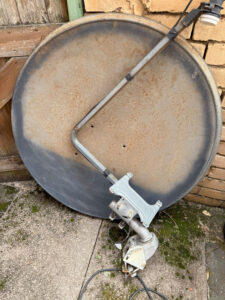 So I needed a satellite dish to start the station build. I put a question out on my Facebook profile asking if any friends had the old-style Sky TV dishes still attached to their house that they no longer use. Tony, G7FSD, one of our club members messaged me with the offer of his old satellite tracking and receiving dish he had as he no longer used it for watching any TV and it was just up in his shed rusting away. Answer “yes please”, with the usual “how much?” etc, but he kindly gave it to me as it was only going in the scrap as he was clearing it out. So we have the first parts of the build. I then sprayed the dish with car primer
So I needed a satellite dish to start the station build. I put a question out on my Facebook profile asking if any friends had the old-style Sky TV dishes still attached to their house that they no longer use. Tony, G7FSD, one of our club members messaged me with the offer of his old satellite tracking and receiving dish he had as he no longer used it for watching any TV and it was just up in his shed rusting away. Answer “yes please”, with the usual “how much?” etc, but he kindly gave it to me as it was only going in the scrap as he was clearing it out. So we have the first parts of the build. I then sprayed the dish with car primer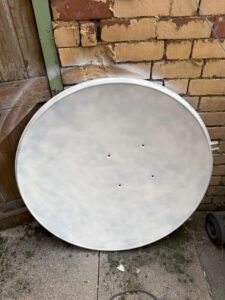 after rubbing it down and getting rid of the surface rust to make it look prettier and give better reflection, again this followed research on the best way to paint the dish.
after rubbing it down and getting rid of the surface rust to make it look prettier and give better reflection, again this followed research on the best way to paint the dish.
Ady, G6AD, was the next donor with a tripod and short stub mast to put the dish on. This not only meant I could get it off the ground, but I would be able to get it above the neighbour’s fence and in clear sight of the satellite. Another bonus.
At first I bought a DX Patrol Low Noise Block (LNB) and receiver/LNB rectifier and Bias-T kit. This enabled me to set up my dish with the LNB and point the dish in the general direction before tweaking to see how well I was receiving signals, and to learn the protocol of using the satellite. I connected the DX Patrol receiver to my SDR Play RSP-1 that has been laying around in the shack redundant into my laptop and SDR Console software.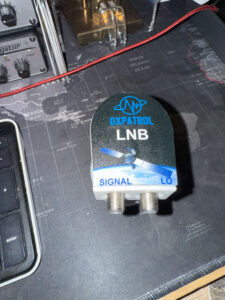
This worked fine to listen to the satellite and get some ideas. But I wanted to answer the callers and be able to call myself, so I looked at an alternative to the 70cm transceiver, with a transverter, that had been my first thought. I looked again at the DX Patrol website and their complete station in a box, which would give everything I needed. I also joined the QO-100 User group on Facebook and asked for advice and any hints/tips that would be the way forward. Plenty of replies with answers and pointing towards YouTube, where I found David Trewren’s (G7IYK) videos where he basis his QO-100 on a Pluto + SDR.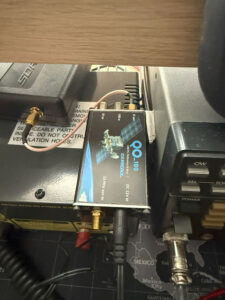
A few notes written down and a search on the internet for the parts and I could get set up and build the kit with a total outlay of around £500.00, which was considerably cheaper than the other suggestions I had had. The Pluto + came from Ali-Express that has a multitude of choice at very reasonable prices, make sure you get the one with 2 receive and 2 transmit ports. Delivery took around 1 week or so and arrived with no issues. A few other bits were found on eBay for less than £20.00, and others had to go direct to manufacturers – the amp is direct from SG Laboratory Ltd in Bulgaria and has a short lead time before it was dispatched . I exchanged emails with Hristiyan (LZ5HP) and paid the money, I was hoping they would be at Friedrichshafen Ham Radio but they were not attending this year, so postage paid and the wait began.
The final thing required was some kind of waterproof housing that could contain everything and allow the completed station to be at the antenna, coax cable losses at 13cm is a lot worse than at VHF/UHF, so the cable run needs to be kept as short as possible. With my build I wanted it to less than 500cm from the amplifier to the antenna on the arm of the dish. It would then only need 1 run of CAT 6 cable, and a length of power lead to feed into the box for the power supply. At this point I had a chat with others who had done this type of build on the Facebook Group and changed my mind on the power feed. As the dish and antennas were going to be close to a disused out building I decided I would run a 240V extension lead into the out building, and have a small 5 amp power supply in there. I would ensure it was waterproof and in the winter make sure it could be kept dry.
More to come as the bits arrive, and I start the building of the “transceiver”.
